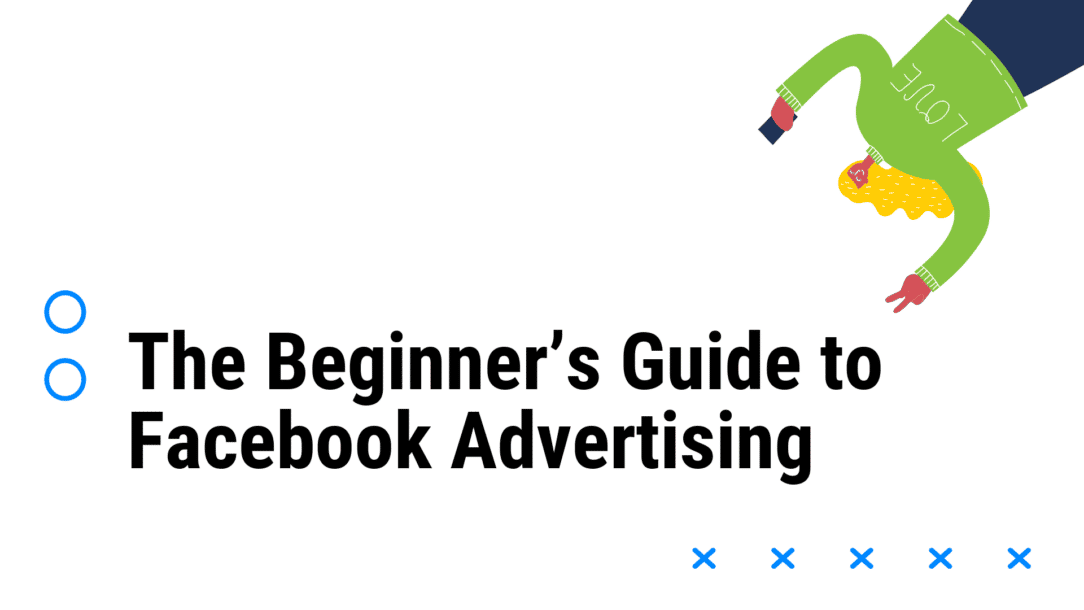Facebook advertising has emerged as one of the most important forms of online advertising over the past couple of years, especially after covid-19. As the world’s largest social media platform with over 2 billion monthly active users, Facebook provides businesses with an incredible opportunity. You can achieve amazing results with Facebook advertising like improved brand awareness, more website traffic, more leads and sales, and so much more. However, with great opportunity comes great competition. In order to get results from Facebook advertising, you need to make sure that your ads are optimized.
Whether you’re just getting started with Facebook advertising or you want to optimize your campaigns for the best possible results, this guide is for you. This comprehensive tutorial will cover the different types of campaigns and ad sets available on Facebook, create compelling ad copy and visuals, and measure and optimize your campaigns for the best results.
So if you’re ready to start generating leads and sales from Facebook advertising, let’s get started! First thing first.
Why Advertise on Facebook?
Facebook – no doubt – is one of the most powerful marketing platforms in the world today. If you’re not using Facebook to market your business, you’re missing out on a lot of potential customers and sales. The average conversion rate on Facebook ads across all industries ranges between 9%-10% – which is significantly higher than any other online marketing channel. But the real power and potential of Facebook advertising lie in its laser-targeted advertising capabilities. Thanks to Facebook’s vast user base, and its incredibly detailed targeting options, you can create highly targeted ads that will speak directly to your target audience.
The best thing about Facebook ads for e-commerce is that you can promote nearly any product you want. Whether it’s an informational product, a physical product, or even a service or coaching program, you can easily promote it on Facebook. This makes Facebook advertising an incredibly powerful platform for e-commerce businesses. But first, let’s look at the different ad campaigns and targeting options available on Facebook. Later in this guide, we’ll also take a look at some of the most effective Facebook advertising tips and best practices that you can use to start generating more leads, sales, and revenue from Facebook.
So let’s get started!
The Different Types of Facebook Advertising Campaigns
Before we dive into the details of how to create effective Facebook ads, it’s important to understand the different types of campaigns that you can run on Facebook.
There are 5 main campaign types:
- Brand awareness campaigns
- Reach campaigns
- Traffic campaigns
- Engagement campaigns
- Lead Generation Campaigns
Let’s look at each of these in more detail.
1. Brand Awareness Campaigns:
A brand awareness campaign is used to grow your reach and increase your brand awareness. This is perfect if you’re a newer brand and are looking to expand your reach to a larger audience. A brand awareness campaign aims not to get people to take action but rather to increase awareness of your brand. This type of campaign is especially useful for e-commerce businesses that sell physical products, as you can boost brand awareness as well as drive traffic to your product catalog.
For instance, check this screenshot from The Ability Center:
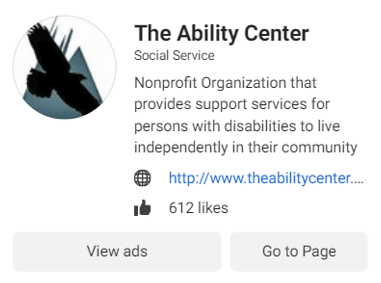
The Ability Center Ad
This is a nonprofit organization that helps disabled people to live independently. They are obviously not running a traffic campaign. And if they were going to run an engagement campaign, the goal would have been to get people to like the page, not to like or comment on a post.
2. Reach Campaigns:
A reach campaign is similar to a brand awareness campaign but with a focus on getting your content seen by as many people as possible. This is perfect if you have a lot of good content but don’t have a large enough following to ensure that a majority of your audience will see it. You can promote your content to a larger audience and get more exposure to your brand. This is also an excellent campaign type if you’re running a sale or promotion and want to ensure that as many people as possible see it.
3. Traffic Campaigns:
Traffic campaigns are designed to get people to your website or app. Clicks are worth more than impressions when it comes to a traffic campaign on Facebook because you’re only paying for results. There are two types of traffic campaigns on Facebook: website clicks and app installs.
- Website clicks: this type of campaign is designed to get people to your website. You will choose a destination URL and pay for the clicks that go to that URL. You will also be able to target people based on the types of websites that they tend to visit.
- App installs: This campaign is designed to get people to install your app. You will be able to target people based on the types of apps they tend to use. You will pay for the number of times that your app is installed.
For instance, check this screenshot for a gaming app:
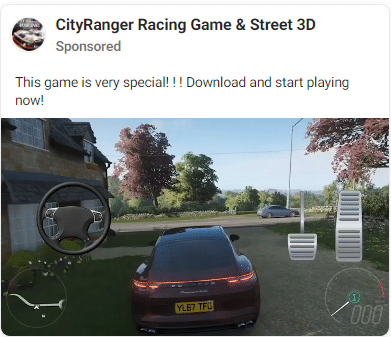
CityRanger Racing Game Ad
The ad above is promoting an app install campaign. And it’s doing a great job at targeting the right audience – people who are likely to download gaming apps.
4. Engagement Campaigns:
Engagement campaigns are designed to get people to take a specific action on your page, such as liking your page, commenting on a post, or sharing a post. This type of campaign is perfect if you’re looking to increase engagement and build relationships with people who are already interested in your brand or products.
For instance, check out this Facebook ad from Daily Trip:
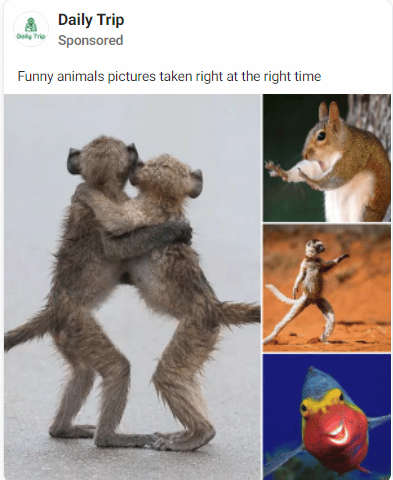
Daily Trip Ad
The ad is showing funny animal pictures taken. Now, if you happen to pass by and see this, you would stop to look at it. It’s definitely eye-catching. But what makes this ad even more effective is the engagement campaign that it’s running.
The goal of the engagement campaign is to get people to like different reactions and make sure people click on the page.
5. Lead Generation Campaigns:
Facebook lead generation campaigns are focused on gaining valuable business data to use in your marketing efforts. This is one of the best ways to grow your subscriber list with ease – and for very little money. You can use lead ads to generate leads for everything from newsletter signups to product purchases.
For instance, check out this Facebook ad from SAF Research:

SAF Research Ads
They are running three ads at a time, and all of them are offering a free ebook copy of their most recent research report. This ad is a great example of a lead generation campaign on Facebook. The goal is to get people to sign up for their newsletter so that they can stay up-to-date on the latest research. To do this, they are offering a free ebook copy of their report in exchange for people’s email addresses. And the ad itself is eye-catching and engaging, which helps drive conversions. When it comes to Facebook advertising, there are various campaign types that you can choose from. The type of campaign that you select will depend on your goals and the type of content that you’re promoting.
There are a few more ad campaigns on Facebook:
- Video views: Campaign to get people to watch your video and increase video views.
- Post engagement: Campaign to get people to like, comment, and share your post.
- Page likes: Campaign to get people to like your page.
- Catalog sales: Campaign to get people to purchase products from your catalog. This is only available to businesses that have an e-commerce store.
- Messages: Campaign to get people to message your business. This is only available to businesses that have a Messenger account.
- Store traffic: Campaign to get people to visit your physical store. This is only available to businesses that have a physical location.
Now you know about the campaigns, how to create them, and their objectives. Let’s see the types of Facebook ads that you can run. There are a variety of different Facebook ad types that you can choose from, depending on your goals and the kind of content that you are promoting. Some of the most common Facebook ad types include:
1. Single Image Ad:
Images are one of the most popular types of Facebook ads. They are easy to create and can be very effective in driving results. When selecting an image for your ad, it’s important to choose one that is high quality and relevant to the content that you are promoting. Single image ads are perfect for promoting products, services, or events. In fact, if you are a complete beginner in Facebook advertisement, you can start with image ads. A study found image ads can outperform images/video ads respectively.
Here are some points to keep in mind while creating ad images:
- Use high-quality images: The image you use should be high quality and relevant to the product, service, or event that you are promoting.
- Don’t just use product images: Sometimes, it can be tempting to use product images for your Facebook ads, but you shouldn’t limit yourself to just that. Try using images of humans if you are selling a product or service, as they can help create a connection with your audience. If selling animal food, use a picture of a dog or cat using it.
- Keep text to a minimum: To ensure that your ad is approved, you should keep the amount of text on your image to a minimum. Facebook has a 20% rule, which states that no more than 20% of your image can be text.
- Emotionally charged images: Research has shown that images that evoke positive or negative emotions tend to perform well on Facebook. So, try to use images that elicit an emotional response from your audience.
Check this screenshot from The Dog Stop:
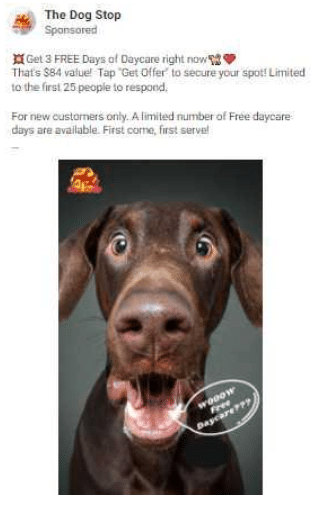
The Dog Stop Ad
This is the perfect ad that includes all the above-mentioned points. It’s a high-quality image of a cute dog, it evokes an emotional response from viewers, and there is very little text. Such ads usually perform well on Facebook and help to generate a lot of engagement.
Ads specifications:
- Image size: 1080 x1080 pixels
- Text: 125 characters
- Headline: 25 characters
- Link description: 30 characters
2. Videos:
Videos, without a doubt, are the most effective type of Facebook ads. Video content tends to generate high engagement on social media, and Facebook is no exception. When creating a video ad, it’s essential to keep your audience in mind. What type of content would they be interested in watching? What would resonate with them? It’s also important to keep your videos short, as people tend to have short attention spans when watching video content on social media. Remember, videos need to attract the viewers in the very first few seconds, so make sure to hook them in from the beginning. You can use video ads to promote products, services, or events. They are perfect for creating brand awareness or driving traffic to your website.
Here are some tips for creating effective video ads:
- Keep them short and sweet: As mentioned earlier, people have short attention spans when watching videos on social media. So, it’s important to keep your videos short and to the point. Aim for videos that are 30 seconds or less.
- Use attractive thumbnails: When people are scrolling through their Facebook newsfeed, they will only see the thumbnail of your video. So, make sure to choose an attractive thumbnail that will grab their attention and make them want to watch your video.
- Use engaging descriptions: Since people won’t be able to hear your video, it’s important to use engaging descriptions. Include some keywords that will interest your audience, and be sure to include a link back to your website or landing page.
- Optimize for mobile: It’s crucial to optimize your videos for mobile, as a vast majority of Facebook users access the site from their mobile devices. Make sure that your videos are compressed and have a lower resolution so that they can load quickly on mobile devices.
Check this video ad screenshot from Wandertails:
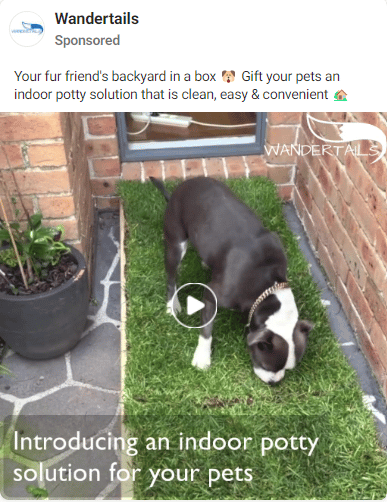
Wandertails Video Ad
This video ad is a great example of how to create engaging and effective Facebook ads. It’s short and to the point; it has an attractive thumbnail, and the description tells you exactly what the video is about.
Ads specifications:
- File size: 4 GB
- Aspect ratio: 4:5
- Resolution: at least 720p
- Length: 15 to 30 seconds are ideal
- Text: 125 characters
- Headline: 25 characters
- Link description: 30 characters
3. Carousel ads:
Carousel ads are another type of Facebook ad that can be very effective. They allow you to show multiple images or videos in one ad, which helps you show more of your products or services to your audience. Carousel ads are the perfect way to showcase multiple products or services at once, increasing the chances of someone finding something that they’re interested in. They are also great for telling a story or giving people a behind-the-scenes look at your company. To create a carousel ad, you simply need to upload several images or videos into one ad. You can then choose how you want them to display and add text to each photo or video.
Check this ad from Rafhan:
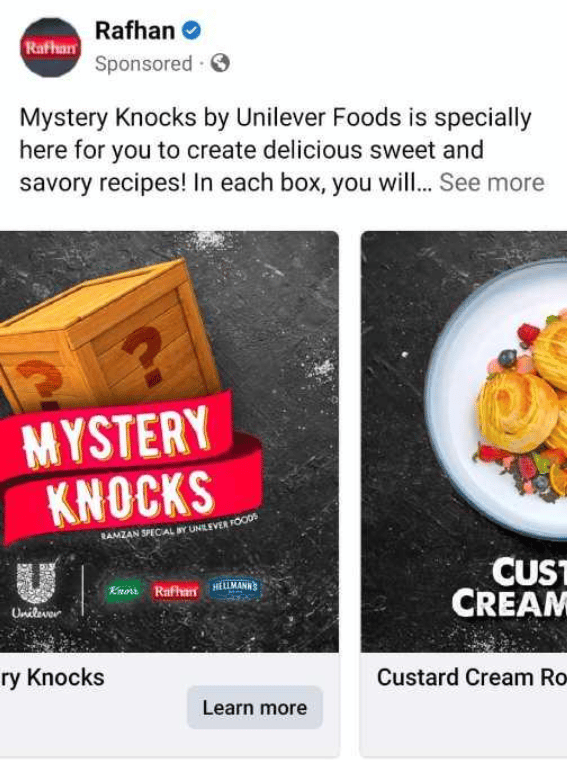
Rafhan Carousel Ad
This is an excellent example of a carousel ad that showcases different products. It’s visually appealing, and it tells you everything you need to know about the products. If you’re looking to create effective Facebook ads, be sure to consider using videos, carousel ads, and other types of content that will resonate with your audience. By creating high-quality, engaging, and relevant ads, you can help boost your brand’s visibility and increase your ROI.
Ads specifications:
- Number of maximum cаrousel cards: 10
- Images: Should be between 1080 x 1080 pixels
- Image size: 30 MB
- Video size: 4 GB
- Video duration: Maximum of 240 minutes and minimum is 1 sec
- Link description: 30 characters
4. Collection Ads:
Collection ads are a newer type of Facebook ad that allows you to showcase multiple products at once. They are perfect for e-commerce businesses as they allow you to show off several products in one ad. These ads are shown to mobile users only and can be a great way to drive sales, as they give people the option to buy your products directly from the ad. Collection ads have a better conversion rate than here; your audience doesn’t have to go outside Facebook and search for your website. Also, you can showcase multiple products, which helps users make a purchase decision.
Here’s an example of a collection ad from Limelight:
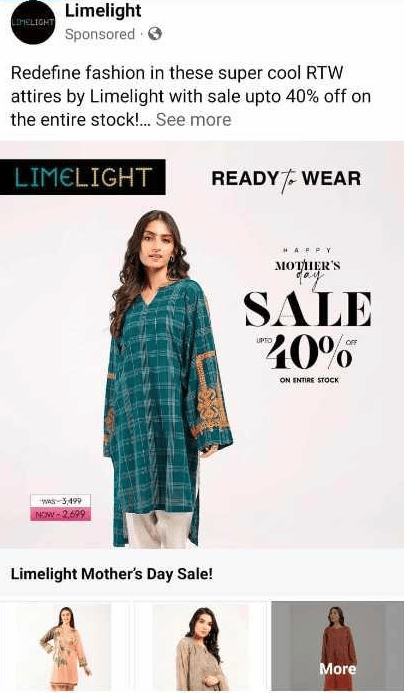
Limelight Ad
Collection ads can be used as a landing page for your products. You can showcase multiple products and also provide some information about each product.
Ads specifications:
- Images: Should be between 1080 x 1080 pixels
- Image size: 5 MB
- Video type: MP4, MOV, or GIF
- Primary text: 125 characters
- Headline: 40 characters
- Link description: 20 characters
5. Instant Experience Ads:
Previously called canvas ads, instant experience ads are another type of Facebook ad that allows you to create a visually appealing and interactive ad. These ads are designed for mobile users and are perfect for businesses that want to showcase their products or services in a creative way.
Instant ads are 15 times faster than any other ads and load almost instantly. They are also very interactive, which can help to increase engagement.
Here is what an Instant ad looks like:

HMUA Ads
When this ad appears on your timeline, it instantly loads and is very interactive. You can click on the links to learn more about the products.
Ads specifications:
- Images: You can have a maximum of 20 images if you want to portray an ad via images
- Image size options: fit-to-width (recommended) or fit-to-height
- Video: You can add more than 1video, but the length of the video should not exceed 2 minutes. But the ideal is still 30 to 60 seconds
- Text: The amount of text should not exceed 500 words
- Character limit: 20,000 characters for headlines and descriptions
6. Dynamic Ads:
Dynamic ads are a type of Facebook ad that allows you to show relevant products or services to people who have already expressed interest in your business. These ads are perfect for businesses that want to retarget their audience and drive sales. For dynamic ads, you need to have a product catalog. This is a database of all the products or services that you offer. Facebook will then use this information to create your ad.
Let’s say a potential customer visited your website but didn’t make a purchase. With dynamic ads, you can show that same customer an ad for the product they were interested in. This is a great way to increase conversions and sales. This helps you to remarket your products to people who have already shown an interest in them.
Check this screenshot:

Desi Oven Ad
You will need to set up a Facebook pixel on your website for dynamic ads. This is a piece of code that allows Facebook to track user behavior on your website. This will help Facebook to show your ad to the right people.
Ads specifications:
- All you need is high-resolution pictures, and Facebook will automatically create your ad.
7. Lead Ads:
Lead ads are a type of Facebook ad that allows you to collect leads from potential customers. These ads are perfect for businesses that want to generate leads and grow their email list. You can collect information from potential customers with lead ads such as names, email addresses, phone numbers, etc. This information can then be used to contact the lead and turn them into a customer.
Here’s how Lead ads look like:
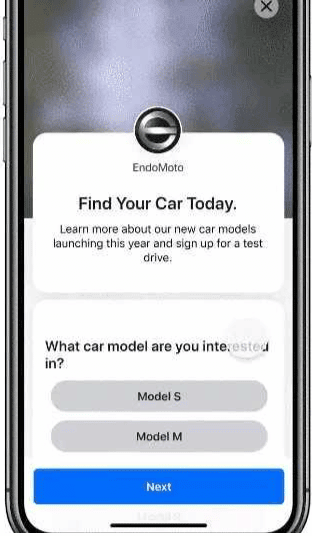
EndoMoto Lead Ad
Ads Specifications:
You can use either images or videos for your ad. You can ask as many as 15 questions for this specific ad and have to link to the privacy policy page of your business so that people know how you will be using their information.
8. Messenger Ads
The last type of ad is Messenger ads. These are ads that are shown in the messenger app and are designed to start a conversation with potential customers. With Messenger ads, you can reach people who are already spending a lot of their time. This is a great way to increase engagement and conversions. Messenger ads can help you increase leads, sales, and customer support. Messenger Ads work extremely well with Clepher as well, check out this article on how you can attach Clepher to Messenger Ads
Here’s an example of a Messenger ad:
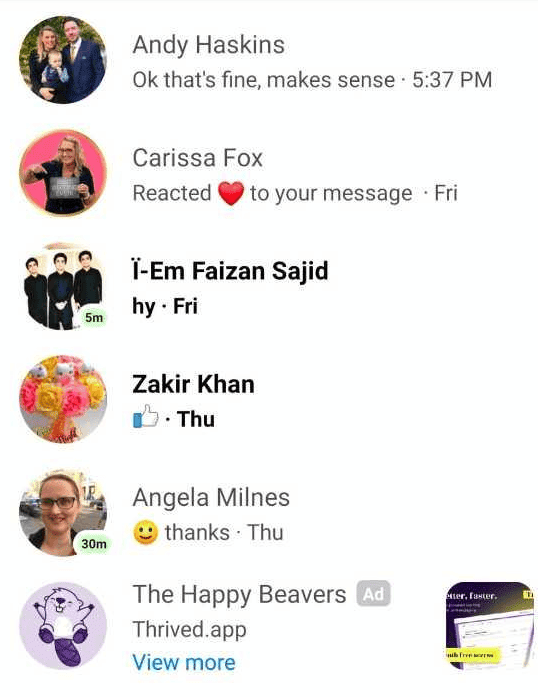
Happy Beavers Messenger Ad
Do you see the ad from The Happy Beavers? When you click on it, you are taken to the Messenger app, where you can chat with the business.
Ads specifications:
- These ads can work with images, videos, or even carousels.
9. Stories Ads:
Stories ads are a new type of ads that have been really helpful for businesses. These ads are designed to be shown in the Stories feature of the Facebook app. With Stories ads, businesses can create short, engaging videos that are perfect for mobile users. The best thing about Stories ads is that they are non-intrusive, and people can watch them even if they don’t have the sound on. These are mobile-only ads, and they can be up to 15 seconds long. Stories ads are a great way to increase brand awareness and reach a larger audience.
Here is an example of a Stories ad:
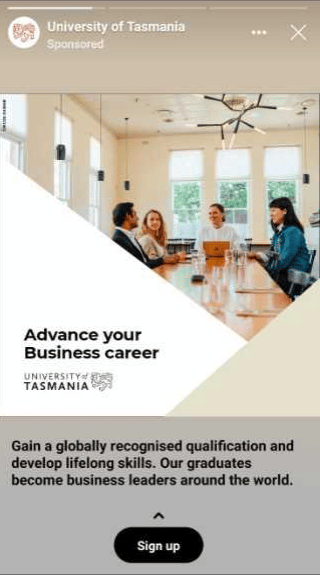
University of Tasmania Stories Ad
SO, there you go! These are the nine types of Facebook ads that you can use to grow your business. If you are looking for a specific type of ad, you can use the search feature on Facebook. Just type in what you are looking for, and Facebook will show you all the available options.
How to Advertise on Facebook?
Now that you know the different types of ads available let’s look at how you can actually create an ad on Facebook. First, you would need a Facebook Business Page, so if you don’t have one already, then create one. Once you have a business page, you can start creating your ad. You would need Facebook Ads Manager for this. We will follow each step so that you can create your first Facebook ad.
Step 1: Choose Your Objective
The first step is to choose your objective. Remember, your objective will determine the type of ad that you create. We talked earlier about types of Facebook ad campaigns. For each type, there are different objectives that you can choose from. Let’s say you want to create an awareness campaign. For this, you can choose the ‘Reach’ objective.
Here are the types of objectives that you can choose from:
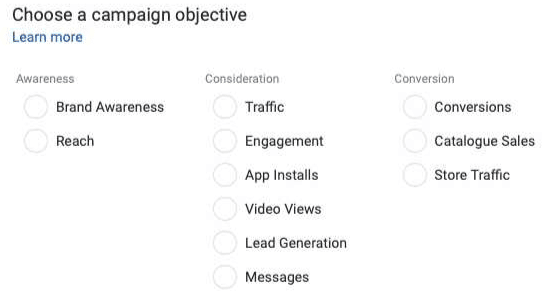
Campaign Objectives
You can also choose different objectives for each ad that you create. For example, you can create one ad to increase brand awareness and another ad to generate leads. For conversion-based objectives, you would pay per action. Now let’s do the engagement for our example.
Step 2: Name Your Campaign
The next step is to name your campaign. This will help you keep track of all your ads in the campaign; go to the ‘Campaign Name’ field and enter a name that is relevant to your campaign. For example, you can simply name the campaign with your objective. So, if you are creating an awareness campaign, you can name it ‘Awareness Campaign.’
Step 3: Set Your Budget and Schedule
The next step is to set your budget and schedule. For the budget, you can either choose a daily or lifetime budget. The lifetime budget is the amount that you are willing to spend on the campaign over its lifetime. The daily budget is the amount that you want to spend on the campaign each day. You can also choose to run your ad continuously or on a specific schedule. If you choose to run your ad on a schedule, you can specify the start and end date for the ad. Once you are done, click on the ‘Continue’ button.
Step 4: Choose Your Audience
The next step is to choose your audience. You can either create a new audience or use a saved audience. To create a new audience, you need to specify the location, age, gender, interests, and behaviors of the people you want to target. You can also choose to target people who are similar to your current customers. Once you have specified your audience, click on the ‘Create Audience’ button.
Detailed targeting:
You can also use the ‘Detailed Targeting’ option to target a specific group of people. For example, you can target people who live in a specific city, are interested in a specific topic, or have engaged with your page in the past. to do this, go to the ‘Detailed Targeting’ section and enter the relevant information.
Exclusions:
You can also choose to exclude people from your target audience. For example, you can exclude people who have already engaged with your page. To do this, go to the ‘Exclusions’ section and enter the relevant information.
Step 5: Choose Your Placement
The next step is to choose your placement. You can either choose ‘Automatic Placements’ or ‘Edit Placements.’ If you choose ‘Automatic Placements,’ Facebook will automatically show your ad to people who are most likely to take the desired action. If you choose ‘Edit Placements,’ then you can manually select where you want your ad to be shown. Remember, you can also choose different placements for each ad that you create.
Step 6: Choose Your Ad Format
The next step is to choose your ad format. For this, you would need to select the ‘Ad Format’ and ‘Ad Product.’ The ad format is the way in which your ad will be displayed on Facebook. For example, you can choose to display your ad as a single image, video, or slideshow. The ad product is the type of ad that you want to create. For example, you can choose to create a ‘Page Like’ ad or a ‘Website Conversion’ ad. Once you have selected the ad format and product, click on the ‘Continue’ button. Since we have talked about all the ad types and products in the previous section, we will not go into detail about each one here.
Step 7: Set Brand Safety and Cost Controls
The next step is to set brand safety and cost controls. Cost controls are the settings you can use to control how much you spend on your campaign. Brand safety controls are the settings that you can use to ensure that your ad is shown to people who are interested in your product or service. For example, you can use the ‘Advanced Matching’ option to show your ad to people who have visited your website in the past. You can also use the ‘Excluded Categories’ option to exclude people who are not interested in your product or service. Once you have set the brand safety and cost controls, click on the ‘Continue’ button.
Step 8: Publish Your Ad
The final step is to publish your ad. To do this, you would need to review your ad and make sure that all the information is correct. Once you have reviewed your ad, click on the ‘Publish’ button. And that’s it! You have now successfully created your first Facebook ad. Now that you know how to create a Facebook ad, it’s time to learn about the different types of Facebook ads that you can create.
How to Measure and Improve Your Facebook Ad Performance?
The first thing you should know is that not every ad you create will be a success. In fact, most of your ads will probably fail. The key is to measure the performance of your ads and then use that data to improve your future ads. Fortunately, Facebook makes it easy to measure the performance of your ads. You simply need to go to Ads Manager and click on the ‘Ads’ tab. There are many metrics that you can measure, but the most important ones are:
Relevance Score:
This is a measure of how relevant your ad is to your target audience. The higher the relevance score, the more likely people are to engage with your ad. You can improve your relevance score by making sure that your ad is relevant to your target audience.
CTR (Click-Through-Rate):
This is a measure of how often people who see your ad click on it. The higher the CTR, the more successful your ad is. You can improve your CTR by using strong images, compelling copy, and relevant targeting.
CPC (Cost-Per-Click):
This is how much you pay each time someone clicks on your ad. The lower the CPC, the more successful your ad is. You can improve your CPC by targeting your ad more narrowly, using relevant keywords, and ensuring your ad is high quality.
Impressions and Reach:
Impressions are the number of times your ad is seen, while reach is the number of people who see it. The higher the impressions and reach, the more successful your ad is. You can improve your reach by targeting your ad more broadly, using relevant keywords, and making sure your ad is high quality.
Results:
The number of people who take the desired action includes clicking on a link, liking your page, or making a purchase. This is the most important metric for success. Facebook tracks these metrics automatically, so you can easily see how your ads are performing. Just go to the “Insights” tab on your page and click “Advertising.” Don’t be discouraged if you see your ads aren’t performing as well as you’d like. Facebook advertising is a complex beast, and it takes time and experimentation to master. Just keep at it, and you’ll eventually find the winning formula for your business.
How Much It Costs to Advertise on Facebook?
The answer to this question depends on a number of factors, including your budget, your goals, and your target audience. Ad Espresso did a detailed research study on the cost of Facebook advertising, and they found it depends on many factors, including:
Timing:
The time of day, day of the week, and month of the year can all affect how much you pay for Facebook ads. For example, ads served during the workweek tended to cost more than ads served on weekends.
Location:
The country, state, and city where your target audience is located can also affect the cost of Facebook ads. Ads served to people in large cities tend to cost more than ads served to people in small towns.
Biding strategy:
The way you set up your ad campaign will also affect how much you pay for Facebook ads. For example, if you choose to “pay per click” (PPC), you’ll pay more for each click than if you choose to “pay per thousand impressions” (CPM).
Ad relevance:
Facebook will also charge you more for ads that are not relevant to your target audience. For example, if you’re targeting men with your ad, but the ad is about women’s clothing, Facebook will charge you more because your ad is not relevant to your target audience.
Ad placement:
The placement of your ad also affects how much you pay for Facebook ads. Ads placed on the newsfeed tend to cost more than ads placed on the right sidebar.
Based on all these factors, Ad Espresso found the following costs for all the main metrics:
CPC by Campaign Objective:
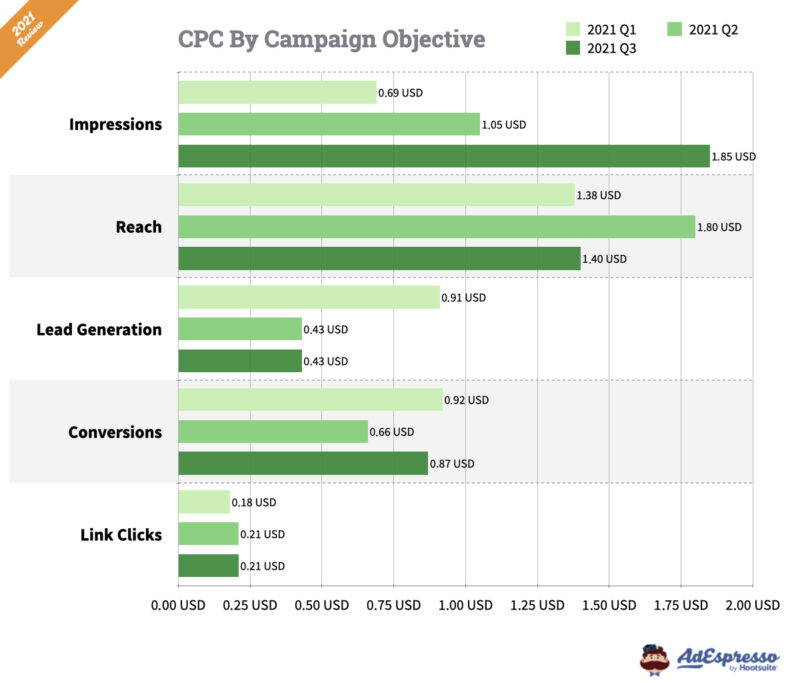
CPC by Campaign Objective
Source: Ad Espresso
Cost Per Like:
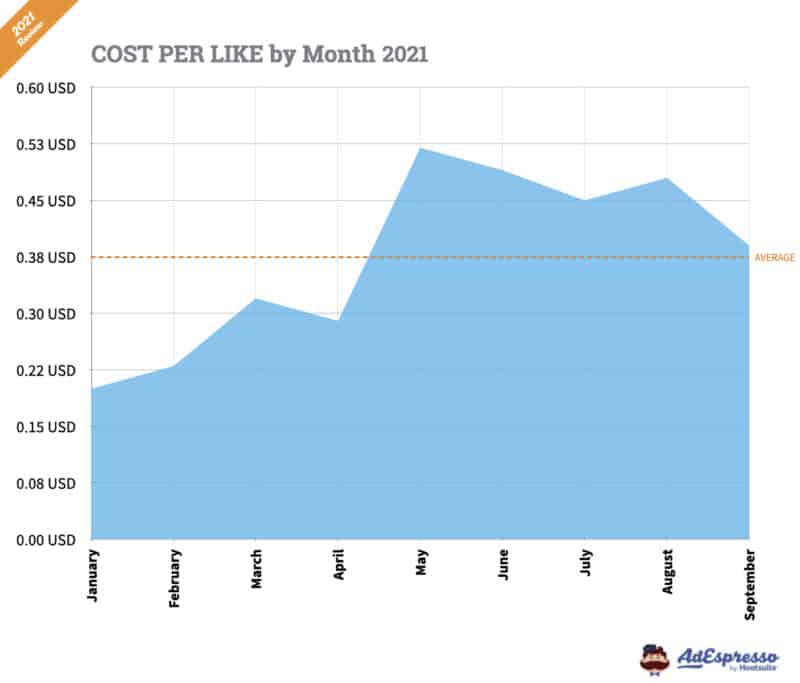
Cost per Like per Month 2021
Source: Ad Espresso
So, how much does Facebook advertising cost? It depends on a number of factors, but you can expect to pay anywhere from $0.10 to $2.00 per click.
Final Verdict:
There you have it! This Beginner’s Guide to Facebook Advertising is a great resource for those just starting with Facebook ads. It covers all the basics, from setting up your ad account to choosing the right bidding strategy. This is everything you need to know about advertising on Facebook. We covered the different types of ads, how to create an ad, target your ad, and measure your success. Now it’s time for you to get out there and start experimenting with Facebook ads. Remember, the key to success is to test, test, test. Try different ad types, targeting options, and bidding strategies until you find what works best for your business.
And don’t forget to measure your results to see what’s working and what’s not. The competition is only getting tougher, so you need to make sure you’re doing everything you can to stay ahead of the curve.
Related Posts

